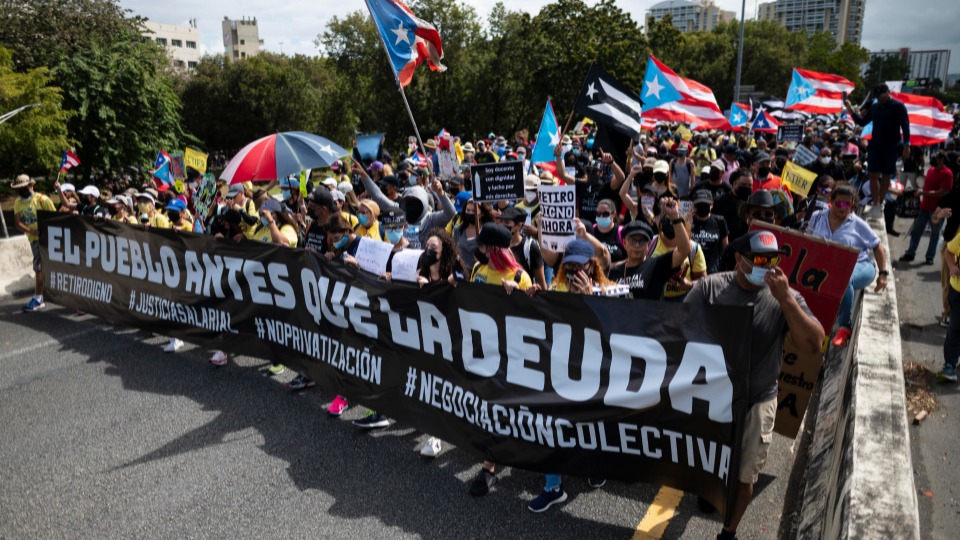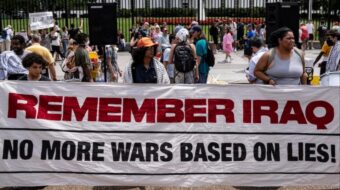
In Puerto Rico on Feb. 18, thousands of publicly-employed union workers, retired workers, and university students took part in a national strike and march that spread throughout the island. The largest contingent filled streets in San Juan. Demonstrators made noise and marched behind a long banner saying, “People before Debt – Salary Justice – Dignified Retirement – Collective Bargaining – No Privatization.”
Their demands grew out of actions of the U.S. government’s Fiscal Oversight and Management Board (FOMB), which was created under the authority of the U.S. Congress’s PROMESA Act of 2016. The island’s government was bankrupt at the time, and the FOMB was charged with negotiating with creditors and implementing austerity in Puerto Rico.
Labor unions participating in this most recent national strike included the Puerto Rican Workers’ Union, the Central Workers’ Federation, the United Auto Workers (for Treasury Department workers), the Electrical Workers’ Union, several teachers’ unions, the University Professors’ Union, and health workers’ unions. Unionized employees of the Highways and Transportation Authority also took part.
Students and teachers have sparked the recent protests. They’ve had no pay raises for 12 years. School closures have skyrocketed as the FOMB has denied funding to public schools while approving them for charter schools. Says one observer: “They are paying investors who are gaining profits from the country’s bankruptcy, and that is immoral.”
The FOMB recently approved public-employee salary hikes. But they were minimal and would only take effect in 2023. Beginning on Feb. 4, 70% of teachers stayed away from classes for six days, as thousands were demonstrating in San Juan and elsewhere on the island. Firefighters and police joined them. Those protests ended with Gov. Pedro Pierluisi promising the teachers an extra $1,000 per month, and firefighters a $500 raise. Funding sources are uncertain.
Puerto Ricans are in distress; 52% of them live below the poverty line, as do almost 60% of their children. Electricity and water bills are almost 60% higher than they are in the United States; food costs are 18% higher. The median family income is $20,500. The salary base for teachers—most are women—is $21,000 annually.
Privatization of the island’s electrical distribution system is emblematic of the FOMB’s brand of austerity. Since June 2021, Luma company has been in charge. It’s a subsidiary of the ATCO and Quanta Corporations, that together provide electrical services in more than 100 countries. Luma’s record is one of frequent blackouts and scant attention paid to damage left-over from Hurricane Maria in 2016 and earthquakes in 2020.
The workings of PROMESA and the FOMB had aroused Puerto Ricans to the point in July 2019 of forcing Gov. Ricardo Rosselló’s resignation, a process made easier through the corruption of some of his appointees. In recent weeks, protesting unionists called upon current Gov. Pedro Pierluisi to resign.
But the island’s government may lack tools for putting the people’s will into effect. Law professor and author José Nicolás Medina Fuentes, for example, regards the current prohibition on political parties forming electoral coalitions as undemocratic. He wants an “alternative to elites holding on to power through a two-party system that bypasses governance by a majority of the people.”
Medina Fuentes points out that in the elections of 2012, the Popular Democratic Party (supporting commonwealth status) and the New Progressive Party (supporting statehood) together gained 96% of the vote, leaving only 4% for the Puerto Rican Independence Party (PIP) and the Working People’s Party.
In 2020, the two major parties accounted for 64.5% of the vote, and the “emerging parties” now attracted 35.5% of the vote. These included the Citizens Victory Movement with 14.3%, the PIP with 13.7%, and Project Dignity with 6.9%. Effectively, he says, 67% of Puerto Ricans “do not govern.” He calls for either of the two major parties to be able to form coalitions with minor parties. A coalition with the PIP, for example, would give visibility to the independence vote.
A major sign of popular rejection of both government and major political parties is Puerto Rico’s increasingly high rate of voter abstention, really of electoral boycott. Voter turn-out for the general elections in 2020 was 50.02%.
Nevertheless, the island’s government by no means bears the main responsibility for difficulties confronting Puerto Ricans in the wake of PROMESA. The underlying, but not always explicit, theme of the recent protests is a call for the island’s association with the United States to be radically altered.
Reporter Monica Cruz cites Jocelyn Velazquez Rodriguez, who is an organizer of the ongoing campaign of demonstrations and strikes. Cruz refers to that campaign as “Jornada Se Acabaron Las Promesas,” which means “On this day we are done with promises!”
Velazquez Rodriguez emphasizes “the impact PROMESA has had on the political consciousness of the Puerto Rican people …[The] PROMESA [law] has been a mechanism that has revealed the true face of US imperialism. It is a law created for a colony, to serve of the imperial interests of the United States. [And for] many Puerto Ricans there has never been a contract, nor an agreement, nor a convention on this.”
She sees “the popular demonstrations…[as] a sample of an awakening of a people that are tired of imperialism, the colonialism, the persecution and the suffering that it has caused us for so many years.”
The existence of colonial rule is not imaginary. The U.S Army invaded and occupied Puerto Rico in 1898. An “Organic Charter” two years later put the U.S. Congress in charge of the island. In 1950, Congress declared Puerto Rico to be a “Free Associated State,” authorized a constitution, and subjected the resulting document to U.S. laws and regulations. Also, there would be no protection from bankruptcy.
The U.S. Internal Revenue Service ruled in 1976 that U.S. companies operating in Puerto Rico would not pay taxes on income or capital gains. U.S. investors would pay no taxes on dividends paid by those companies. Nor were taxes due on U.S. investments deposited in Puerto Rican banks.
Previously, exploiters had counted on low-wage textile jobs and agricultural work for their profits. U.S. chemical and electronic manufacturers rushed to a Puerto Rico converted into a tax-free haven. A tax attorney quoted by The New York Times referred to the IRS tax leniency as “nothing but a welfare program for the Fortune 500.”
Meanwhile, Puerto Rico’s government had to rely on “multi-million” dollar loans to compensate for reduced tax collections. After 1990, U.S. authorities gradually restored taxation, and the manufacturers departed. To cover expenses, Puerto Rico’s government issued bonds held by U.S. banks, hedge funds, and corporations. Indebtedness mounted. Bankruptcy required rescue, of sorts—and thus came the PROMESA law of 2016.










